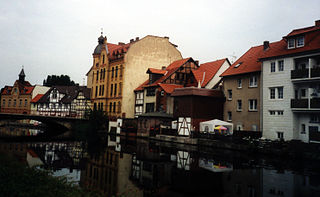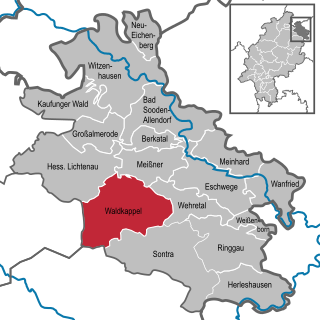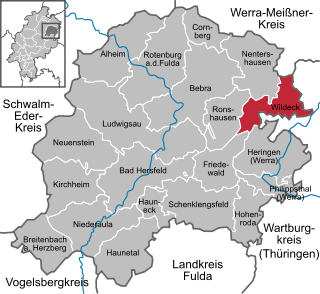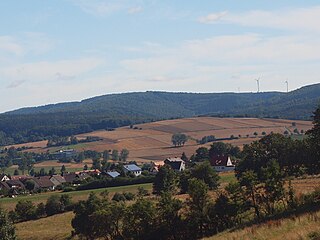
Potash includes various mined and manufactured salts that contain potassium in water-soluble form. The name derives from pot ash, plant ashes or wood ash soaked in water in a pot, the primary means of manufacturing potash before the Industrial Era. The word potassium is derived from potash.
Schwalm-Eder-Kreis is a Kreis (district) in the north of Hesse, Germany. Neighbouring districts are Kassel, Werra-Meißner, Hersfeld-Rotenburg, Vogelsberg, Marburg-Biedenkopf, and Waldeck-Frankenberg.

Eschwege, the district seat of the Werra-Meißner-Kreis, is a town in northeastern Hesse, Germany. In 1971, the town hosted the eleventh Hessentag state festival.
The Military Geology Unit was a unit in the United States military during World War II. It was established on June 24, 1942, six months after Pearl Harbor. People in the US Geological Survey wanted to get involved in the war effort, either for patriotism or prestige or both, and provided a geological intelligence report for a randomly chosen country, Sierra Leone.

A spoil tip is a pile built of accumulated spoil – waste material removed during mining. These waste materials are typically composed of shale, as well as smaller quantities of Carboniferous sandstone and other residues. Spoil tips are not formed of slag, but in some areas, such as England and Wales, they are referred to as slag heaps. In Scotland the word bing is used.

Waldkappel is a small town in the Werra-Meißner-Kreis district in northern Hesse, Germany.

Philippsthal (Werra) is a market community in Hersfeld-Rotenburg district in eastern Hesse, Germany, right at the boundary with Thuringia.

Wintershall Holding GmbH, based in Kassel, was Germany's largest crude oil and natural gas producer. It was a wholly owned subsidiary of BASF. The company was active in oil and gas exploration and production with operations in Europe, North Africa, South America as well as Russia and the Middle East region. Wintershall employed more than 2,000 people worldwide. In the 2018 financial year the company produced around 171 million barrels of oil equivalent (boe) of oil and gas. Revenues amounted to 4.09 billion euros.

Meißner is a municipality in the Werra-Meißner-Kreis in Hesse, Germany.

Ringgau is a municipality in the Werra-Meißner-Kreis in Hesse, Germany.

Wildeck is a municipality in Hersfeld-Rotenburg district in northeastern Hesse, Germany lying right at the boundary with Thuringia, 54 km southeast of Kassel.

Nentershausen is a community in Hersfeld-Rotenburg district in northeastern Hesse, Germany.
Mining in the United States has been active since the beginning of colonial times, but became a major industry in the 19th century with a number of new mineral discoveries causing a series of mining rushes. In 2015, the value of coal, metals, and industrial minerals mined in the United States was US $109.6 billion. 158,000 workers were directly employed by the mining industry.

Monte Kali and Kalimanjaro are local colloquial names for the spoil heap or spoil tip that towers over the town of Heringen, Hesse, Germany. It is one of a number of sites where the K+S chemical company dumps sodium chloride, a byproduct of potash mining and processing, a major industry in the area.

The United States Geological Survey Library is a program within the United States Geological Survey, a scientific bureau within the Department of Interior of the United States government. The USGS operates as a fact-finding research organization with no regulatory responsibility.

Michael Helmut Roth is a German politician of the Social Democratic Party of Germany (SPD) who has been serving as a member of the German Bundestag since 27 September 1998.

Bad Salzungen station is the railway station of the town of Bad Salzungen in the German state of Thuringia. It is located on the Werra Railway and on the Werra Valley Railway.

The Salzungen Werra Upland is a natural region in Germany that forms part of the East Hesse Highlands in the German states of Hesse and Thuringia.

The Seulingswald is a hill range in the German Central Uplands which reaches heights of up to 480.3 m above sea level (NHN). It is part of the Fulda-Werra Uplands in the East Hesse Highlands within the Hessian county of Hersfeld-Rotenburg; small ridges extend into the Thuringian county of Wartburgkreis. It is a sandstone range and one of the largest contiguous woodland areas in Hesse.

The American occupation zone was one of the four occupation zones established by the Allies of World War II in Germany west of the Oder–Neisse line in July 1945, around two months after the German surrender and the end of World War II in Europe. It was controlled by the Office of Military Government, United States (OMGUS) and ceased to exist after the establishment of the Federal Republic of Germany on 21 September 1949.



























